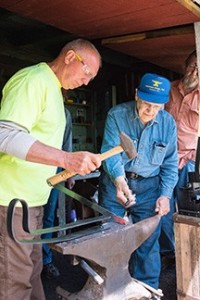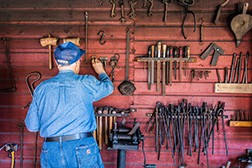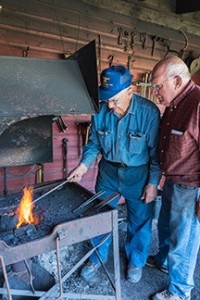Age-Old Trade Makes A Comeback in Door County
- Share
- Tweet
- Pin
- Share

Instructor Al Briggs demonstrates how to form a hinge to student Bob Hatala as instructor Larry Stuth looks on.
A staple of the economic infrastructure in the 1800s is making a comeback on the Door Peninsula. Blacksmithing, presented by the Door County Historical Society, is being taught at the Blacksmith Shop in the Petersen Granary located at the Heritage Village at Big Creek in Sturgeon Bay.
“Historically, villages had to have a blacksmith,” says Mel Henrichs, an assistant with the blacksmith events at Heritage Village. “From time to time a blacksmith would pass away and that could be a real threat to a village’s existence.”
Henrichs is part of a core group at Big Creek that is heavily involved with this trade of antiquity.
“After I retired my wife suggested that I come with to Heritage Hill (a state historical park in Green Bay) and they assigned me to the blacksmith shop. Nineteen years later I’m still doing it,” says Al Briggs, a former clergyman of the United Methodist Church.
Briggs is the longest tenured member of the blacksmith ensemble at Heritage Hill and has maximized his retirement by his full immersion into this classic trade and using his knowledge to benefit the historically inclined community at large.
Henrichs has been involved with the organization for about six years and was a helpful guide in discussing and conveying the nuances of the blacksmithing process. One of the goals of the class is to “try and recreate a typical 1910, small village Door County blacksmith shop,” Henrichs says.

Instructor Al Briggs selects a tool from the blacksmith shop wall at Heritage Village at Big Creek in Sturgeon Bay.
“For me, it’s a matter of being able to interpret to people who come out here, particularly children, what the blacksmith shop was like 100 years ago.”
Participants involved in the four-week class (Tuesday and Thursday afternoons from 1 to 3 pm) learn the basics of blacksmithing and gain enough knowledge to continue on with their own work independently if they so choose.
On the day I visited Heritage Village, the class attendees were shaping the hot metal into intricately designed leaves. It was a cool rainy day and the heat from the coal permeated the small shop, providing amiable warmth that accentuated the early 20th century backdrop. The reverberating sound of metal on metal could be heard from across the parking lot as the searing leaves were being forged into metallic bloom.
Several anvils, the blacksmith’s work surface, were stationed across the small shop. A blacksmith’s primary tools consist of a hammer, vice, tongs and a forge. The forge is a hearth that contains the coal necessary to shape the scorching metal from the smith’s imagination to manifestation.

Instructor Al Briggs and Mel Henrichs at the forge.
“You have to go along with what the metal wants to do, and then use your imagination from there,” Briggs says.
In order to get the needed temperature to mold the metal, the forge is heated to about 2,000 degrees (yikes!). Once the forge is at this sultry level, the impurities have been burnt off to a point where the smoke begins to filter out and the shop is clear to precede with the work.
At this point the metal is immersed into the blistering bed of coals and becomes flexible enough for the blacksmith to mold and fashion into the desired result. With Thor-like strength, the metal is pounded over the anvil with keen accuracy so as to keep the necessitated design intact.
Any damage or mistakes made when shaping the metal can usually be fixed and worked back into place. The only error that can’t be forgiven is if the metal is burnt, the charring typically requiring the blacksmith to try again with a new piece of steel.
It may no longer be a primary source of income, but the niche work created by the blacksmiths of Heritage Village and the students is something that echoes the historic genesis of human ingenuity and creativity.



